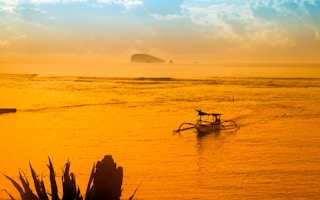Marine and fisheries activists in Indonesia are ramping up their calls for the revocation of a new government regulation allowing the export of sea sand, saying the policy will benefit foreign interests more than local fishers and marine ecosystems.
The regulation, issued in May to end a longstanding prohibition, says sand extracted from the seabed may be sold abroad as long as producers prioritise domestic demand for use in reclamation work and other infrastructure development projects. It also limits dredging to open-water marine areas where “natural” sedimentation has occurred, while excluding sea-sand exploitation from coastal areas and small islands.
Susan Herawati, general secretary of the advocacy group Coalition for Fisheries Justice (KIARA), said the new regulation directly threatens the future of Indonesian fishing and coastal communities in the world’s largest archipelagic nation, where the livelihoods of millions of people hinge on the sustainability and health of the marine ecosystem.
“It’s not too late for the government to revoke or cancel this government regulation because it’s not in line with the people’s interests for ecological protection and the sustainability of traditional fishers in Indonesia,” Susan said.
An estimated 2.7 million Indonesians are employed in marine fisheries, most of them small-scale fishers. Under the business-as-usual scenario, the country’s marine capture fishery is projected to grow at an annual rate of 2.1 per cent from 2012-2030. Data from the fisheries ministry show that the average total catch over the past five years was 7 million metric tons annually, valued at up to 140 trillion rupiah (US$9.2 billion).
“
There’s no kind of [resource] extraction that doesn’t cause environmental damage.
Susan Herawati, general secretary, Coalition for Fisheries Justice
Susan said dredging deposited sand from the sea would likely deteriorate ocean health, particularly in terms of changing currents and subsequently affecting waves and increasing the potential for coastal abrasion.
She added that sand-dredging activities already taking place across Indonesia have often caused harm to fishing and coastal communities. One prominent case in South Sulawesi province has sparked fierce resistance by fishers against a dredging in their waters. The fishing community says the dredging activity has disrupted traditional fishing grounds, leading to a decline in catches of up to two-thirds since dredging began in February 2021.
“There’s no kind of [resource] extraction that doesn’t cause environmental damage,” Susan said.
Indonesia first prohibited sea sand exports in 2003 — though it continued to allow dredging to meet domestic demand for sand — and doubled down on the policy in 2007 in an effort to combat illegal shipments, mostly to neighbouring Singapore, which has built entire islands from Indonesian sand.
The Indonesian fisheries ministry said it would issue a decree elaborating more stringent measures for environmental protection to ensure marine habitats won’t be destroyed by dredging for sea sand.
The fisheries ministry will form a study team with officials from the energy ministry and the environment ministry, as well as academics and independent environmental groups to scout potential sites for dredging. They will then determine whether the sea sand there comprises deposits due to natural occurrences, and then allocate that sand for either domestic or export needs. Once the locations and volumes allowed to be dredged have been determined, the government will issue permits to paying companies with the capability to dredge sea sand, the ministry said.
Data from Indonesian environmental NGO Auriga Nusantara show the government has issued 141 marine dredging concessions to 118 businesses, covering a total area of 131,157 hectares (324,096 acres), or twice the size of Jakarta. KIARA noted the country also has reclamation projects with a total size of 3.5 million hectares (8.6 million acres). The fisheries government estimated in 2021 that 1.87 million cubic meters (66 million cubic feet) of sand would be needed to supply reclamation projects throughout the country.
Indonesia’s reclamation projects aim to mimic Singapore’s island-building spree, which peaked before the export ban was instated. The city-state expanded its land area by 20 per cent from 1965 to 2017 through reclamation projects, and its government plans to further expand it by 30 per cent by 2030. Before the 2003 ban, Indonesia had exported 53 million metric tons of sand annually between 1997-2002, much of it to Singapore.
Parid Ridwanuddin, the coastal and marine manager at Walhi, Indonesia’s biggest environmental advocacy group, said the resumption of exports will benefit foreign interests at the expense of Indonesian local fishers and coastal communities. He said that China, which has been building new islets in the South China Sea to support its claims to the disputed region, could benefit from the policy. (Unlike most other countries in the region, Indonesia doesn’t have overlapping claims with China to parts of the South China Sea.)
“It means that this government regulation may expedite the threat of drowning for coastal villages and small islands in Indonesia,” Parid said.
This story was published with permission from Mongabay.com.

















